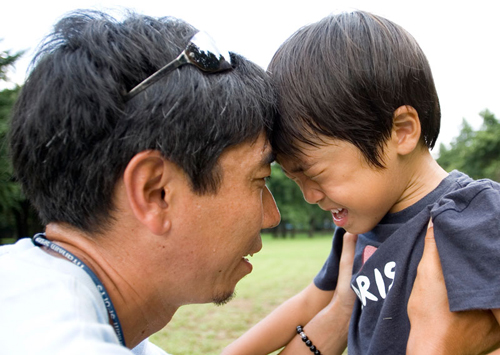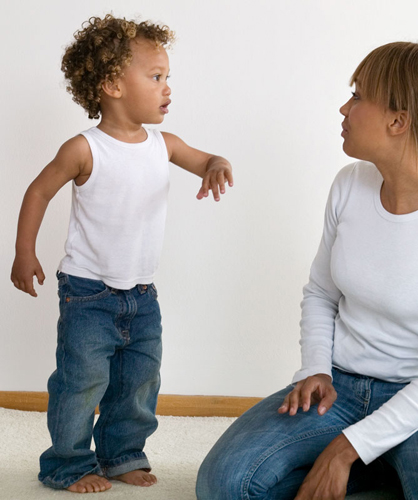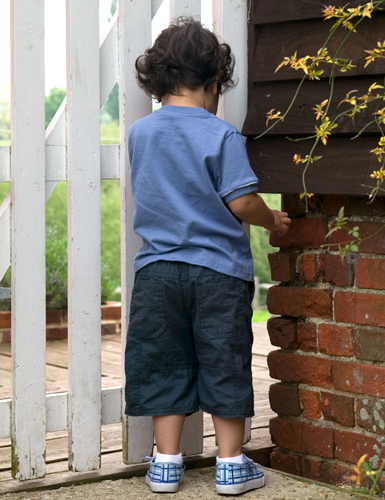Consequences
Helping your toddler
manage his angry mood, or stop unwanted behavior, is challenging and
time consuming, and time is often in short supply. If behavior-shaping
is to work, your toddler will need to understand that there will be a
negative consequence if he does not do as he has been asked—or a
positive consequence if he does.
An important aspect
of seeing problems off before they begin is to ensure that your toddler
has a clear idea of your expectations. A young brain needs clear and
simple instructions. Try using if and then, or when and then, so he understands the cause and effect of his behavior.
Examples of if, then; when, then:
Your toddler will need
the consequences to be very simple and immediate, as he will not be
able to relate to “later.” A negative consequence normally involves
something being taken away, such as not being able to take teddy
shopping, or not coming with Mommy. A positive consequence is usually
more effective and will involve something being given, such as playing
with Daddy, or having a favorite story at bedtime, if he does as you
ask. The treats should be simple, everyday “favorite things,” rather
than candy or gifts.
When stating a
consequence, you must be consistent, and you must follow through with
what you have said—otherwise it becomes meaningless. Your response needs
to show your child that you are serious about the boundary you have
set, and if he crosses that boundary, that his behavior is unacceptable.
If a tantrum or aggression results, ignore it—and remember he will grow
out of this phase before long. Whatever his action and response, still
treat him with respect.
Help him learn
He is beginning to understand the consequences of his behavior,
but it is important to keep explanations very simple at this age.

“If you speak quietly, then we can go to the park.”
“When you are nice to your sister, then you can play catch with her.”
The art of ignoring
To be disregarded
and overlooked is the ultimate negative consequence for your young
child. Your toddler is used to thinking of himself as being the center
point of the family. To suddenly discover that no one is interested in
him is a powerful behavior deterrent for the future. This style of
ignoring is not about withdrawing affection and is not meant as a
malicious or vindictive act. It is an immediate and effective tool to
stop unwanted behavior. It works because it isolates your toddler and
gives him an opportunity to calm down.
Remember that
ignoring your child is not ignoring if you remain focused on and looking
at him. For it to work, you need to remove eye contact and stop talking
to him, to show apparent disregard (while always ensuring he remains
safe). If he is sitting on your knee just reduce your attention for a
time (see Letting go and moving on).
This approach can sometimes work after a few seconds and at other times
may take up to two or three minutes (although don’t continue for any
longer at this age). Once he has become calm you can re-engage with him.
If, for example, you are in a
crowded supermarket and your toddler starts to grab things from the
shelf, disregarding your instruction to stop and being defiant, you have
two choices: either to ignore him and continue to shop, or to ignore
him and leave the supermarket immediately. Leaving the store is not a
good option since it will give your child too much power—he will think
that when he is bored he just has to “act out” and Mommy will take him
home. Do not look at him or talk to him. Once he has calmed down, give
him a hug. You could then suggest playing the “find the color” game,
where you find colored packages on the shelves, or other supermarket games.
Your toddler will learn from this that calm behavior is rewarded with
hugs and a game, and that being defiant and ignoring your instructions
won’t reap rewards.
To give another
example, perhaps your friend has come over who you have not seen for a
long time. Your toddler has plenty to keep him occupied, but he keeps
screaming because he wants your undivided attention. You both physically
turn away from your toddler and ignore his behavior completely. Once he
has calmed down, turn to him and say, “Come and have a hug.” Introduce
your friend and show him that his “good” behavior gets attention and
praise.
Ignoring can also work well if combined with distraction techniques.
Distraction works well as a way of changing your toddler’s mood in an
instant. This is less likely to work, however, if a full-scale tantrum
is in place. “Time out”
and variations of this, such as “the naughty step,” are other forms of
ignoring that can be used briefly to calm your child if he is aggressive
or out of control.
Selective behavior
You might discover that
your toddler only behaves in a certain way when he is with you, and that
he does not act up for other people. There could be several reasons for
this, but often it is because you are the only one that responds to his
behavior. It has worked. He has got the attention he wanted (for
example, you have given him treats). You can take strength from the fact
that children grow out of this phase. Your toddler will gradually learn
how to manage his feelings appropriately and find better ways to get
what he wants. In the meantime, however, remember not to reinforce his
behavior by reasoning with him. Withdrawing attention is still more
effective than talking and negotiating at this age.
Aggressive behavior
A firm “No” and removing positive reinforcement, such as fun toys
for a limited time, sends a message that aggressive behavior is not
acceptable.

Letting go and moving on
It is always a relief to be
able to make up after a disagreement, and never more so than when your
child is calm and ready to apologize. The time to ask him for an apology
is after the consequence of his behavior has run its course. The tears
are over, he is calm, he has had time to reflect, and everyone wants to
be friends again. It is a hard lesson for a toddler to learn, but it is
important that he understands that he has to learn to say “sorry” as
part of the process of taking responsibility for his behavior.
At 2–3 years, it is unlikely
that a toddler will truly “feel” sorry—he has not yet developed
sufficient empathy and understanding of others to feel the effects of
his behavior on someone else. However, it is an important response to
begin to teach. When your child has done something to physically or
emotionally hurt someone else and you ask him to say sorry, you are
teaching him an important social skill. Over the next 18 months he will
start to feel increasing levels of empathy and will begin to really mean
it when he says it. An apology is a vital part of behavior-shaping
because it will help him understand that we must take responsibility for
the impact of our behavior on others. Your toddler does something
wrong, you put him right, he apologizes—everyone moves on. He needs to
feel safe in the understanding that no matter what he does, you will
still love him. Making up and moving on is vital in showing him that his
behavior was unwanted, but he is still loved and wanted as a person.
Your challenge is then to “let go” of the event and to try not to use it
to label his behavior, or to bring it up again when he misbehaves at a
later date. Do be aware, though, that your toddler saying “sorry”
shouldn’t stop you following through with a consequence for bad
behavior.
Putting space between thought and deed
As a parent, it is normal
to frequently overestimate your child’s ability to understand the
reasons why you are unhappy with his behavior. Even now his brain has
developed further, he will learn more by what you show him than what you
tell him. Putting space between his thoughts and his deeds is the most
effective way to stop the unwanted behavior.
Distraction, ignoring,
holding, and “time out” are all ways to help him learn to calm himself
and choose to act differently. In the next section there is a
description of how to use “time out”,
a more extreme form of ignoring. It is more suitable for slightly older
children and is used as a technique to help children to cool down and
reflect on their actions. It should ideally be used only after all other
methods have failed. If your child is completely out of control, has
been aggressive—especially toward another child—or is being extremely
antisocial in some way and needs to learn to modify his behavior, then
“time out” can be used in the 24–36 month age group as well, but for no
longer than two minutes. A more appropriate technique is firm holding
(see Managing extreme behavior).
Time to reflect
Sending your toddler to a safe place to calm down following
unwanted behavior is a good technique, which can be used more as he gets
older.

Seeking help
Poor toddler behavior can
instill intense feelings of guilt or hopelessness in many parents. If
you are having ongoing problems with managing your child, do not suffer
in isolation. Ask your pediatrician for help, join a parenting class or
workshop, or ask other mothers for advice.
Some of what you are
experiencing will be normal toddler behavior, which will pass in time,
but it can be helpful to speak to other parents, to keep things in
perspective and normalize your child’s behavior.
Recognizing patterns of behavior
Toddlers become conditioned to respond in certain ways to particular situations, as this example shows:
Lara knows Daddy well.
She has learned to recognize his mood by how he acts when he comes home
from work. If he throws his keys on to the table, sighs deeply, and
slumps into a chair, she knows that he is in a bad mood, which means he
will have no patience with her. Over time, her response to this sequence
becomes conditioned, so that thrown keys (Daddy is angry) becomes a
trigger for her to stay out of the way (I feel rejected). But if he is
humming a tune as he walks through the door, and hangs his keys on the
hook, she knows he is in a good mood and is likely to give her a hug. In
time, the conditioned response becomes Dad humming his favorite tune
(Daddy is happy), which triggers an impulse to run up and hug him (I
feel loved).
Managing extreme behavior
Some toddlers take their
behavior to extremes. Occasionally this is about attention-seeking and
finding their parent’s weak spot, but more often it is triggered by
overwhelming feelings that they cannot control.
Actions such as
banging his head as a tantrum reaches its peak, or holding his breath
are alarming, upsetting, and very hard to manage. No parent can ignore a
child who is distressed or hurting himself, so what is the best course
of action and coping?
Very, very careful holding may be helpful:
Minimize the
amount of attention you are paying to your child and his actions. It is
possible to hold your child firmly, to keep him safe, without giving
him positive attention.
Carefully
hold him, facing outward, against your body. His head should be against
your chest so that he doesn’t smack it into your face. (Say no more
than “No, calm down,” occasionally and very softly).
If
your child is holding his breath, he will eventually gasp for air and
cannot harm himself, but you can also try splashing a little water on,
or blowing gently into, his face
Do
not rise to the bait and panic, and do not give in to the temptation to
talk to him or pay attention to what he is doing or saying. If you give
in once, then next time it will be twice as difficult to handle.
Wait until he is calm to give him positive attention.